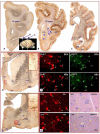Natural non-trasgenic animal models for research in Alzheimer's disease
- PMID: 19355852
- PMCID: PMC2825666
- DOI: 10.2174/156720509787602834
Natural non-trasgenic animal models for research in Alzheimer's disease
Abstract
The most common animal models currently used for Alzheimer disease (AD) research are transgenic mice that express a mutant form of human Abeta precursor protein (APP) and/or some of the enzymes implicated in their metabolic processing. However, these transgenic mice carry their own APP and APP-processing enzymes, which may interfere in the production of different amyloid-beta (Abeta) peptides encoded by the human transgenes. Additionally, the genetic backgrounds of the different transgenic mice are a possible confounding factor with regard to crucial aspects of AD that they may (or may not) reproduce. Thus, although the usefulness of transgenic mice is undisputed, we hypothesized that additional relevant information on the physiopathology of AD could be obtained from other natural non-transgenic models. We have analyzed the chick embryo and the dog, which may be better experimental models because their enzymatic machinery for processing APP is almost identical to that of humans. The chick embryo is extremely easy to access and manipulate. It could be an advantageous natural model in which to study the cell biology and developmental function of APP and a potential assay system for drugs that regulate APP processing. The dog suffers from an age-related syndrome of cognitive dysfunction that naturally reproduces key aspects of AD including Abeta cortical pathology, neuronal degeneration and learning and memory disabilities. However, dense core neuritic plaques and neurofibrillary tangles have not been consistently demonstrated in the dog. Thus, these species may be natural models with which to study the biology of AD, and could also serve as assay systems for Abeta-targeted drugs or new therapeutic strategies against this devastating disease.
Figures

Similar articles
-
[Experimental models for Alzheimer's disease research].Rev Neurol. 2006 Mar 1-15;42(5):297-301. Rev Neurol. 2006. PMID: 16538593 Review. Spanish.
-
Amyloid precursor protein processing and retinal pathology in mouse models of Alzheimer's disease.Graefes Arch Clin Exp Ophthalmol. 2009 Sep;247(9):1213-21. doi: 10.1007/s00417-009-1060-3. Epub 2009 Mar 7. Graefes Arch Clin Exp Ophthalmol. 2009. PMID: 19271231
-
APP/Go protein Gβγ-complex signaling mediates Aβ degeneration and cognitive impairment in Alzheimer's disease models.Neurobiol Aging. 2018 Apr;64:44-57. doi: 10.1016/j.neurobiolaging.2017.12.013. Epub 2017 Dec 20. Neurobiol Aging. 2018. PMID: 29331876
-
Alzheimer's disease.Subcell Biochem. 2012;65:329-52. doi: 10.1007/978-94-007-5416-4_14. Subcell Biochem. 2012. PMID: 23225010 Review.
-
Presenilin 1 transgene addition to amyloid precursor protein overexpressing transgenic rats increases amyloid beta 42 levels and results in loss of memory retention.BMC Neurosci. 2016 Jul 7;17(1):46. doi: 10.1186/s12868-016-0281-8. BMC Neurosci. 2016. PMID: 27388605 Free PMC article.
Cited by
-
Spontaneous and induced nontransgenic animal models of AD: modeling AD using combinatorial approach.Am J Alzheimers Dis Other Demen. 2013 Jun;28(4):318-26. doi: 10.1177/1533317513488914. Epub 2013 May 17. Am J Alzheimers Dis Other Demen. 2013. PMID: 23687185 Free PMC article. Review.
-
Preclinical Models for Alzheimer's Disease: Past, Present, and Future Approaches.ACS Omega. 2022 Dec 13;7(51):47504-47517. doi: 10.1021/acsomega.2c05609. eCollection 2022 Dec 27. ACS Omega. 2022. PMID: 36591205 Free PMC article. Review.
-
Neurodegenerative Diseases: What Can Be Learned from Toothed Whales?Neurosci Bull. 2025 Feb;41(2):326-338. doi: 10.1007/s12264-024-01310-2. Epub 2024 Nov 1. Neurosci Bull. 2025. PMID: 39485652 Free PMC article.
-
Circadian control of heparan sulfate levels times phagocytosis of amyloid beta aggregates.PLoS Genet. 2022 Feb 10;18(2):e1009994. doi: 10.1371/journal.pgen.1009994. eCollection 2022 Feb. PLoS Genet. 2022. PMID: 35143487 Free PMC article.
-
Increased immunoreactivities of cleaved αII-spectrin and cleaved caspase-3 in the aged dog spinal cord.Neurochem Res. 2012 Mar;37(3):480-6. doi: 10.1007/s11064-011-0633-9. Epub 2011 Oct 30. Neurochem Res. 2012. PMID: 22037840
References
-
- Saura CA, Choi SY, Beglopoulos V, Malkani S, Zhang D, Shankaranarayana Rao BS, et al. Loss of presenilin function causes impairments of memory and synaptic plasticity followed by age-dependent neurodegeneration. Neuron. 2004;42:23–36. - PubMed
-
- Luo Y, Bolon B, Kahn S, Bennett BD, Babu-Khan S, Denis P, et al. Mice deficient in BACE1, the Alzheimer's beta-secretase, have normal phenotype and abolished beta-amyloid generation. Nat Neurosci. 2001;4:231–2. - PubMed
-
- Muller U, Cristina N, Li ZW, Wolfer DP, Lipp HP, Rulicke T, et al. Behavioral and anatomical deficits in mice homozygous for a modified beta-amyloid precursor protein gene. Cell. 1994;79:755–65. - PubMed
Publication types
MeSH terms
Substances
LinkOut - more resources
Full Text Sources
Other Literature Sources
Medical
